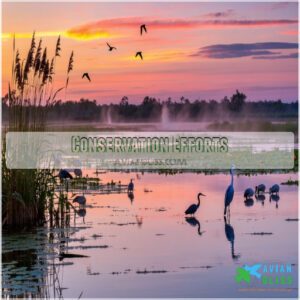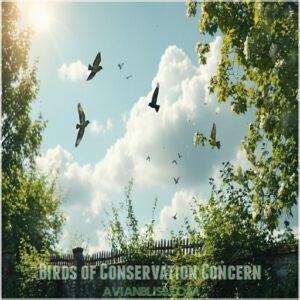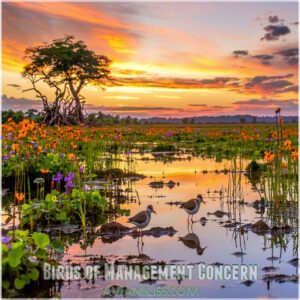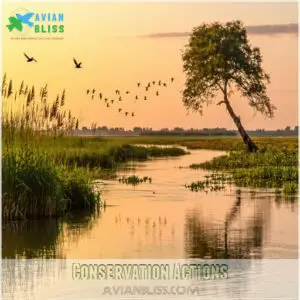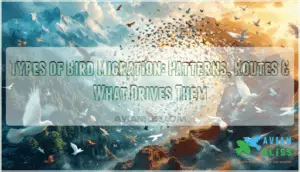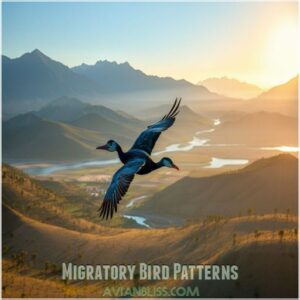This site is supported by our readers. We may earn a commission, at no cost to you, if you purchase through links.
 The migratory bird species list, protected under the Migratory Bird Treaty Act (MBTA), includes over 1,000 native species, from graceful waterfowl like ducks and geese to vibrant songbirds such as warblers.
The migratory bird species list, protected under the Migratory Bird Treaty Act (MBTA), includes over 1,000 native species, from graceful waterfowl like ducks and geese to vibrant songbirds such as warblers.
These feathered travelers undertake astonishing journeys, traversing flyways spanning continents—often braving harsh weather and human-made threats like habitat loss.
Managed by the U.S. Fish and Wildlife Service, the list evolves to reflect current taxonomy and guarantee conservation aligns with global efforts, while nonnative birds aren’t covered, the MBTA guarantees focused protection for natives, balancing ecosystems.
Curious about their challenges and strategies for survival? It’s quite the flight to follow!
Table Of Contents
- Key Takeaways
- Migratory Bird Treaty Act
- Bird Migration Patterns
- Conservation Efforts
- Focal Species Conservation
- Protected Species Examples
- Frequently Asked Questions (FAQs)
- What are migratory bird species?
- How are migratory birds listed?
- How many migratory birds are there?
- What are some examples of migratory birds?
- What animals migrate?
- Which birds do not migrate?
- How many species of migratory birds are there?
- What birds are protected by federal law?
- What is the most migratory bird?
- What birds fall under the Migratory Bird Act?
- Conclusion
Key Takeaways
- You’ll find over 1,000 native bird species protected by the Migratory Bird Treaty Act, ensuring their survival through strict regulations on hunting, trade, and habitat protection.
- These birds take epic migratory journeys along established flyways, facing threats like habitat loss, climate change, and human-made hazards like light pollution and skyscrapers.
- The MBTA doesn’t protect nonnative species, emphasizing native birds and balancing ecosystems through focused conservation strategies.
- Conservation efforts like habitat restoration, stopover site protection, and climate change mitigation play a critical role in supporting migratory bird populations.
Migratory Bird Treaty Act
You’ll find the Migratory Bird Treaty Act (MBTA) is a cornerstone of avian conservation, ensuring legal protections for over 1,000 migratory species.
By enforcing strict regulations on activities like hunting and trade, it reflects international cooperation to safeguard these birds and their habitats.
Protected Species List
The migratory bird species list under the MBTA safeguards native birds like ducks, flamingos, and cuckoos.
Updated in 2023, it incorporates current bird taxonomy and natural distribution.
This protected bird species roster guarantees conservation status clarity, aiding in preserving endangered species.
By staying anchored in science, this list guarantees accurate species classification while prioritizing migratory bird protection.
The list is based on the Migratory Bird Treaty Act regulations and international agreements.
Exclusions and Exceptions
Not all birds are on the migratory bird species list under the MBTA.
Nonnative bird species introduced by humans don’t qualify.
The exclusion criteria focus on naturally occurring native species.
Human impact is a big factor, and here’s what’s left out:
- Invasive, human-imported species.
- Domesticated breeds like pigeons.
- Non-migratory species with limited habitats.
Understanding bird migration patterns is essential for conservation efforts, focusing on native species.
Permit Requirements
Understanding the fine print of the Migratory Bird Treaty Act matters regarding permits.
Whether you’re into bird banding, species trade, or handling import regulations, the US Fish and Wildlife Service manages migratory bird permits.
Permit applications safeguard protected birds under strict export controls.
Always check the migratory bird species list to confirm you’re following permit requirements with care.
Bird Migration Patterns
Every year, millions of migratory bird species set out on remarkable journeys, following defined avian migration routes called flyways.
These seasonal bird movements are driven by the search for food, ideal breeding conditions, and safe habitats.
Migration patterns vary—some birds travel thousands of miles across continents, while others settle closer within local habitats.
Factors like altitude changes, wind patterns, and geographical barriers shape their routes.
Birds often choose these paths instinctively or through learned behaviors.
Night migrations are common, offering protection from predators, while daytime flights can align with favorable wind conditions.
Understanding migratory bird patterns is vital for effective conservation efforts, as it reveals the complex interactions between birds and their environments.
Tracking technology has revolutionized understanding of bird migration patterns, revealing precise seasonal movements and highlighting the need for flyway conservation to protect critical migratory bird habitats worldwide.
Conservation Efforts
Protecting migratory birds requires addressing threats like habitat loss, climate change, and human-made hazards, which disrupt their survival and reproduction.
Through international cooperation and targeted conservation strategies, you can help safeguard key stopover sites and guarantee sustainable environments for these species.
Migration Hazards
It’s no walk in the park for migratory bird species.
Their journeys include threats like disappearing habitats and heightened collision risks.
Human activities amplify these dangers:
- Collision Risks: Skyscrapers and wind turbines disrupt bird migration patterns.
- Pollution Effects: Contaminated water and air weaken birds.
- Habitat Destruction: Stopover sites vanish due to urbanization.
- Storm Impacts: Stronger weather events increase mortality.
- Disorientation: Light pollution confuses nocturnal migrators.
Protecting Stopover Sites
When migratory bird species stop to rest along their migration routes, they need protected stopover sites for fuel and safety.
Habitat restoration and site preservation support their survival, maintaining ecological balance.
Imagine bird sanctuaries as pit stops—resting spots for long-distance flyers.
Protecting these habitats guarantees migratory bird conservation thrives.
Planting Bird Friendly Seeds can substantially enhance the quality of these stopover sites.
| Benefit | Challenge |
|---|---|
| Rest and refueling | Competition for food |
| Safer migration routes | Human disturbances |
| Stable ecological balance | Habitat loss |
| Encourages biodiversity | Overcrowding issues |
| Supports bird health | Resource depletion |
Climate Change Impact
Bird migration faces huge challenges from climate change.
Shifts in temperature and rising sea levels disrupt ecosystems, leaving birds scrambling for food and nesting.
Weather extremes make survival risky, while habitat loss destroys critical stopover sites.
Here’s how climate impacts migratory bird species:
- Altered migratory patterns
- Reduced breeding success
- Increased predation risks
- Loss of key habitats
- Ecosystem imbalances
The combination of these factors poses a significant threat to the survival of migratory bird species, highlighting the need to address ecosystem imbalances.
Focal Species Conservation
You play a pivotal role in safeguarding migratory birds by understanding which species need targeted conservation efforts.
Focal species strategies prioritize actions for at-risk populations, ensuring they recover to sustainable levels while addressing habitat loss and other threats.
Birds of Conservation Concern
Some migratory bird species face significant risks, landing them on the Birds of Conservation Concern list.
This list highlights endangered bird species needing focused bird conservation efforts, through species monitoring, recovery plans, and habitat preservation, conservation status is assessed, guiding action.
Swift, House Martin, and Greenfinch are examples, reminding us that migratory bird species conservation requires active threat assessment to guarantee their future, which is crucial for the success of conservation efforts.
Birds of Management Concern
Birds of Management Concern spotlight migratory bird species facing population decline, habitat loss, or dependence on fragile environments.
This bird species list includes those needing specialized management strategies for survival, and challenges include balancing efforts for overabundant species while addressing risks for endangered bird species.
Bird monitoring plays a key role in migratory bird conservation efforts, especially for species whose habitats are shrinking rapidly.
Effective conservation requires understanding the importance of habitat restoration to protect endangered bird species and their ecosystems.
Conservation Actions
Effective conservation actions focus on habitat restoration, species monitoring, and protecting ecosystem balance.
By preserving biodiversity through wildlife preservation initiatives, you help migratory bird species thrive.
Programs like the Migratory Bird Treaty Act and the Endangered Species Act target vulnerable populations.
These efforts, from safeguarding stopover sites to enhancing bird conservation strategies, are critical for long-term sustainability and ecosystem health.
Conservationists often rely on Bird Conservation methods to support their work in protecting migratory bird species, which is a key part of bird conservation.
Protected Species Examples
You’ll find that protected migratory bird species include a diverse array of examples, ranging from waterfowl to songbirds, each governed by specific criteria under conservation laws.
Understanding these examples helps you appreciate the importance of preserving biodiversity and the intricate roles these birds play within ecosystems.
Anseriformes Family
The Anseriformes family includes ducks, geese, and swans, a standout group on the migratory bird species list.
These waterfowl showcase fascinating feather adaptations for flight and buoyancy, critical for survival.
- Ducks thrive in diverse habitats, from wetlands to urban ponds.
- Goose migration spans continents, highlighting endurance.
- Swans’ elegance masks their resilient nature.
- Effective waterfowl conservation guarantees species balance.
- Bird taxonomy reveals remarkable biodiversity.
Understanding the impact of invasive species like the eurasian tree sparrow is vital for maintaining ecosystem health.
Anatidae Family
The Anatidae family, part of Anseriformes, includes ducks, geese, and swans, showcasing remarkable feather adaptations for water.
Understanding their roles in Duck Habitat and Goose Migration is essential for Waterfowl Conservation.
From bird species identification to migratory bird behavior, these species connect ecosystems worldwide.
Ongoing bird migration research drives migratory bird species preservation, ensuring balanced habitats and sustainable biodiversity across continents.
Studying the Duck Migration patterns helps in devising effective conservation strategies for protected species.
Other Protected Species
Protecting migratory bird species like raptors, shorebirds, and eagles is no small feat.
These protected species, key in wildlife preservation, face threats like habitat loss and collisions.
Conservation actions under programs like the Endangered Species Act aim to monitor conservation status, support bird sanctuaries, and further species research.
Together, these efforts guarantee that Birds of Conservation Concern thrive safely.
Frequently Asked Questions (FAQs)
What are migratory bird species?
Migratory bird species are birds that journey seasonally between breeding and wintering grounds.
Driven by food and daylight changes, these epic travelers navigate flyways, facing risks like habitat loss, harsh weather, and human threats.
How are migratory birds listed?
Creating the migratory bird list isn’t rocket science; it’s rooted in science.
This process guarantees the list reflects reality, safeguarding these incredible travelers worldwide.
Experts evaluate species based on natural occurrence, taxonomy updates, and evidence, which ensures the list is accurate and reality-based.
How many migratory birds are there?
Roughly 1,100 bird species are protected under the Migratory Bird Treaty Act.
This includes diverse species naturally spanning across borders.
Conservation lists are updated regularly, reflecting scientific research, taxonomy, and global distribution adjustments, which can impact the conservation lists.
What are some examples of migratory birds?
Think of geese flying in a perfect "V"; they’re just one example.
Add Arctic Terns, Swainson’s Hawks, and Ruby-throated Hummingbirds—each migrating incredible distances, showcasing nature’s endurance and adaptability across continents and climates.
What animals migrate?
Animals like whales, elephants, caribou, monarch butterflies, and sea turtles migrate to survive.
They move in search of food, breeding grounds, or warmer climates, showcasing nature’s incredible instinct for survival and adaptation.
Which birds do not migrate?
Some birds stick to their roots and skip the migration drama.
They are species like cardinals, chickadees, and woodpeckers that stay put year-round.
These birds rely on local food sources and adapting to seasonal changes instead of hitting the skies.
How many species of migratory birds are there?
Migration is the ultimate road trip for birds, and over 1,000 species worldwide take part in this epic journey.
Each species’ route unfolds across continents, driven by survival, food needs, and seasonal changes.
What birds are protected by federal law?
Under the Migratory Bird Treaty Act, over 1,000 bird species are federally protected, including hawks, swans, ducks, and sparrows.
It’s illegal to capture, harm, or trade them without a proper permit, ensuring conservation.
What is the most migratory bird?
Imagine wings never resting—Arctic Terns take the crown as the most migratory bird, flying over 44,000 miles annually between polar regions.
They chase endless summers, proving nature’s endurance knows no limits.
What birds fall under the Migratory Bird Act?
Under the Migratory Bird Treaty Act, many birds, from swans to songbirds, are protected.
It covers species native to the U.S., like robins and herons, but skips non-native introductions like house sparrows.
Conclusion
Imagine crossing continents with the endurance of a marathon runner—migratory birds do this every year.
The migratory bird species list, protected under the MBTA, highlights the intricate role these species play in ecosystems and emphasizes the importance of habitat conservation.
From protecting stopover sites to mitigating climate change impacts, your actions can support these avian athletes’ remarkable journeys.
By understanding their challenges and contributing to conservation, you help preserve both biodiversity and the global balance of nature.
- https://en.wikipedia.org/wiki/Bird_migration
- https://www.fws.gov/program/migratory-birds/species
- https://www.federalregister.gov/documents/2020/04/16/2020-06782/list-of-bird-species-to-which-the-migratory-bird-treaty-act-does-not-apply
- https://www.migratorybirdday.org/featured-species/2024-featured-species/
- https://www.ecfr.gov/cgi-bin/text-idx?SID=b85587342ebe4f607983dfb6d1e07461&mc=true&node=se50.1.10_113&rgn=div8


